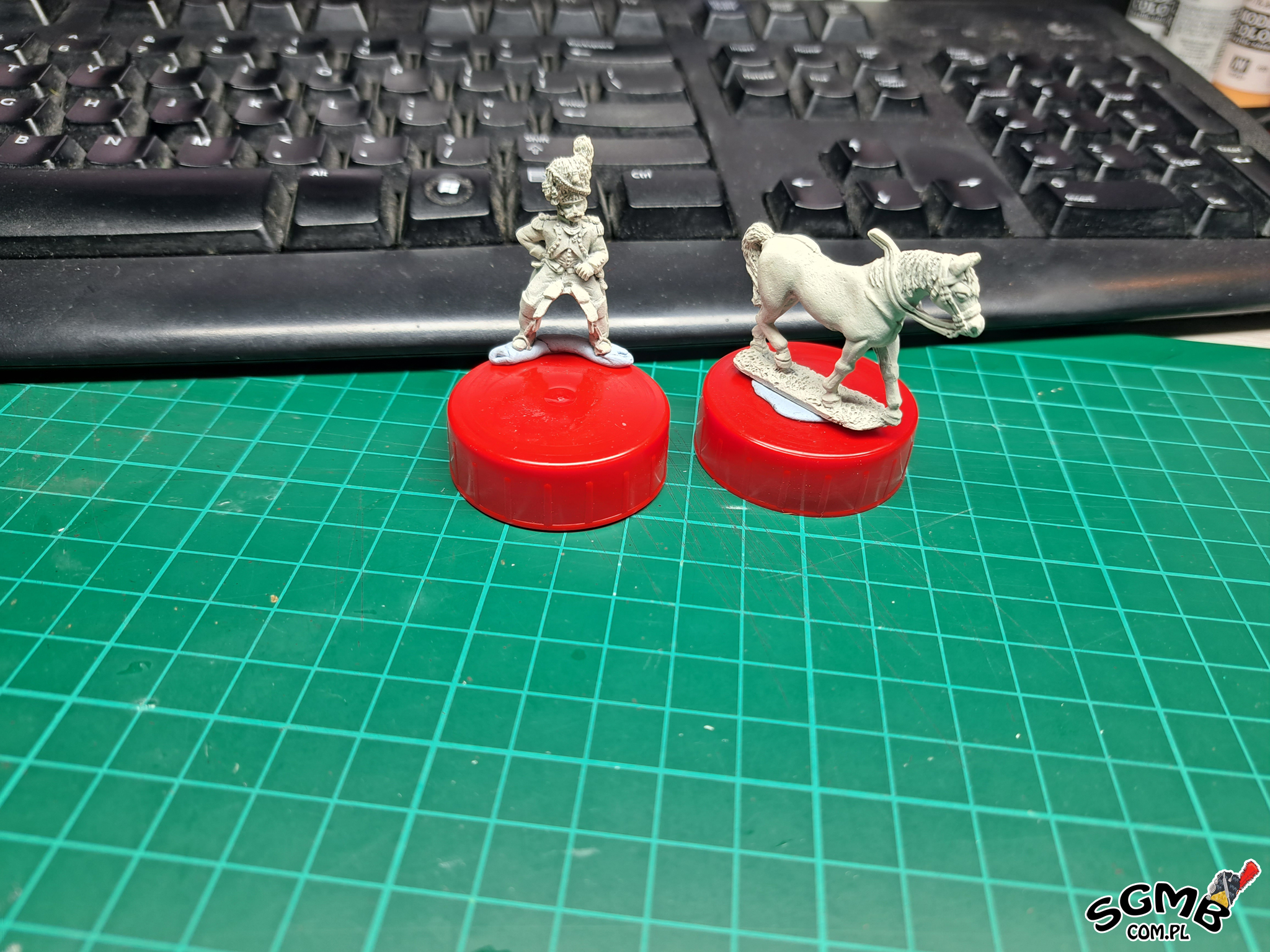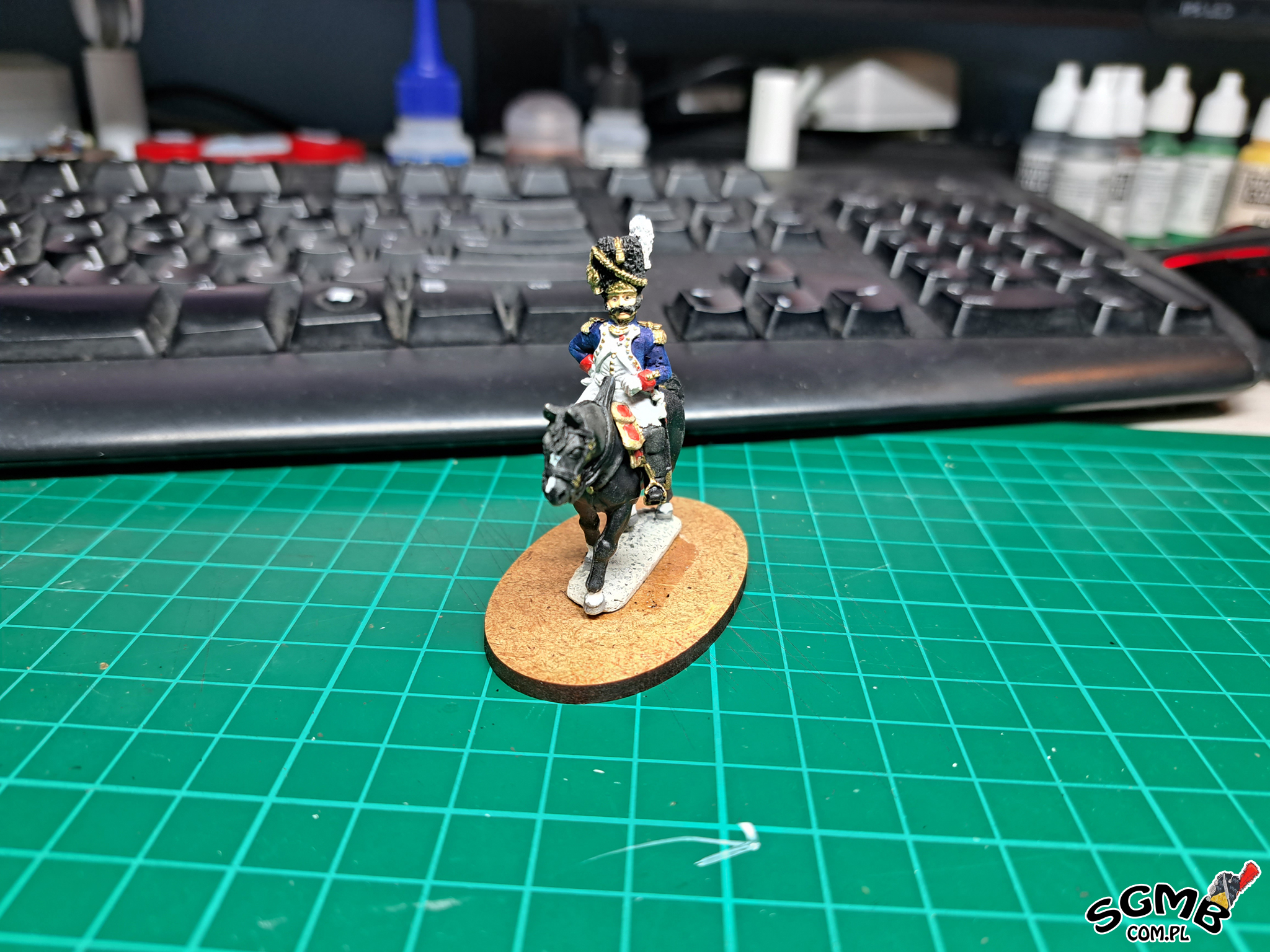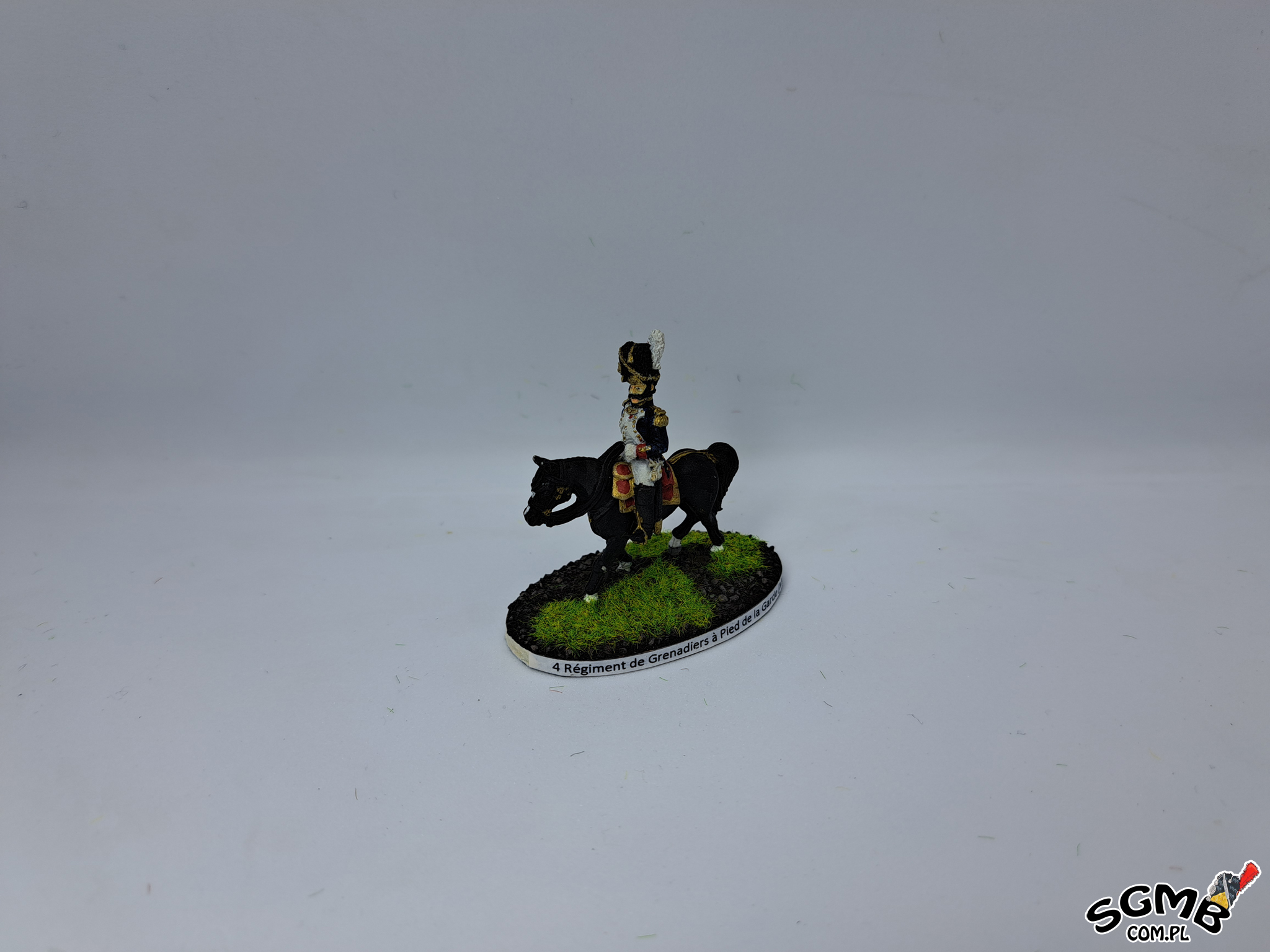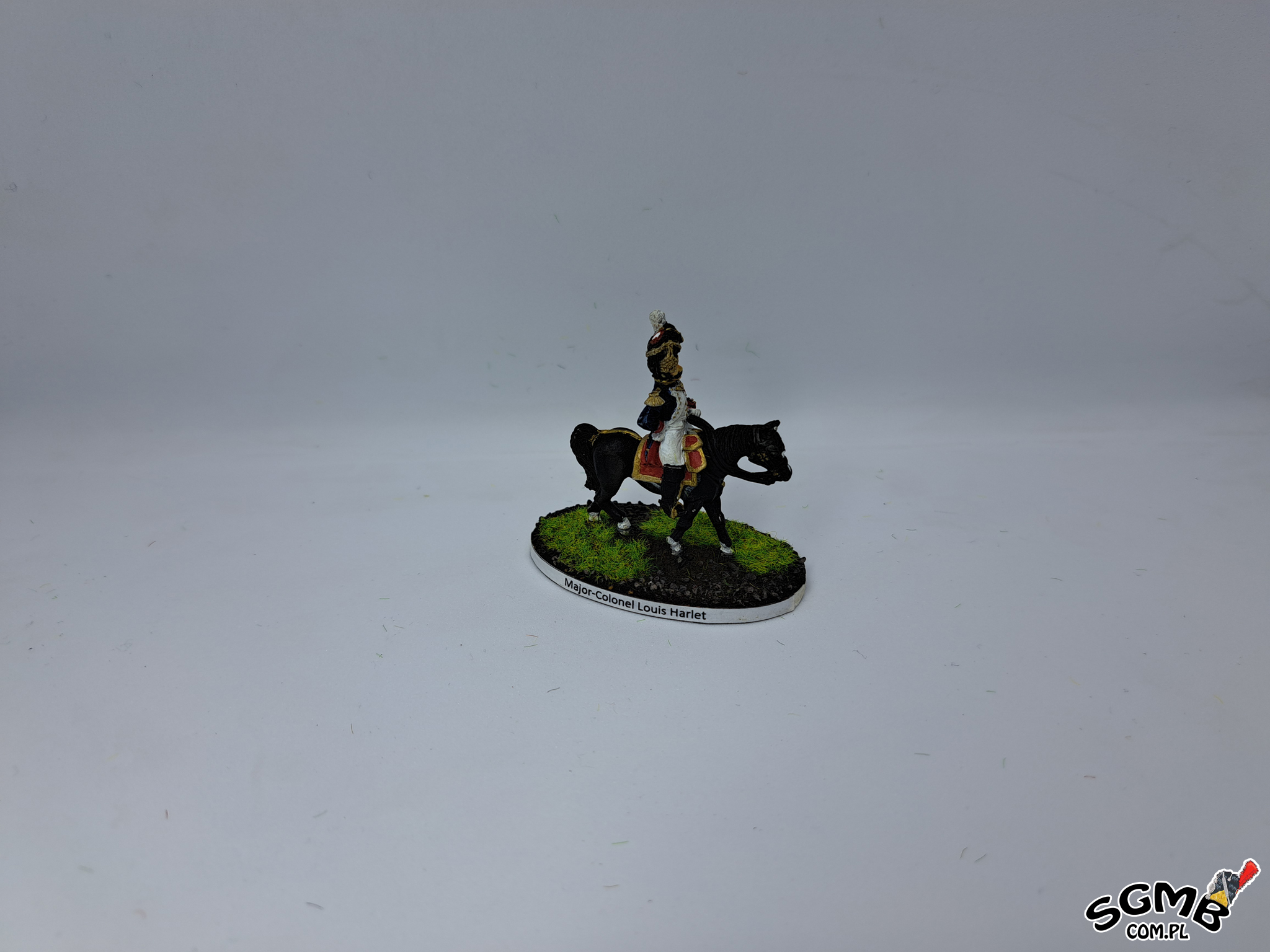[27.10.2023] Wojny Napoleońskie 28mm - Francja [1815]
|
4 Pułk Grenadierów Pieszych Gwardii - Major-Colonel Louis Harlet.
Dowódca 4 Pułku Grenadierów Pieszych Gwardii. |
4th Guards Foot Grenadier Regiment - Major-Colonel Louis Harlet.
Commander of the 4th Guards Foot Grenadier Regiment. |
4ème Régiment de Grenadiers à Pied de la Garde - Major-Colonel Louis Harlet [1815]
|
Louis Harlet, urodzony 15 sierpnia 1772 w Broyes w Marnie, a zmarł 2 marca 1853 w Sézanne w tym samym departamencie, w swoim domu w Champ-Benoist.
Syn notariusza Louisa Ferdinanda Harleta i Jeanne Marie Caritte, trzeci z dziewięciorga dzieci w rodzinie.
Służbę rozpoczął 4 września 1791 w stopniu porucznika 3 batalionu ochotników narodowych nad Marną, a 28 maja 1793 przeniósł się do 8 batalionu ochotników narodowych Orleanu, który miał zostać włączony do 64 półbrygady. Został mianowany kapitanem 1 czerwca 1793 r., a 22 grudnia 1793 r. został ranny w lewą nogę w bitwie pod Savenay. W 1797 został przydzielony do armii włoskiej, gdzie 27 listopada 1798 został ranny w lewe ramię w bitwie pod Terni. Odznaczył się zdobyciem Kapui 10 stycznia 1799 r. i Neapolem 23 stycznia 1799 r. W latach 1800–1804 służył w Armii Zachodu i Armii Wybrzeży Oceanu. Kawalerem Legii Honorowej został 6 sierpnia 1804 roku. 30 sierpnia 1805 roku został mianowany kapitanem Grenadierów Gwardii Cesarskiej, a 16 lutego 1807 roku szefem batalionu w Pułku Strzelców Gwardii Cesarskiej. W 1808 roku brał udział w kampanii hiszpańskiej, a 4 września 1808 roku został mianowany oficerem Legii Honorowej. 6 lipca 1809 roku został przydzielony do 1 Pułku Grenadierów Pieszych Gwardii Cesarskiej. 15 marca 1810 roku został mianowany baronem cesarstwa. 24 czerwca 1811 roku został mianowany majorem-pułkownikiem 2 Pułku Grenadierów Pieszych Gwardii Cesarskiej i brał udział w kampanii rosyjskiej. Awansował do stopnia generała brygady 13 kwietnia 1813 roku i brał udział w kampanii w Saksonii na czele 2 brygady piechoty 19. dywizji generała Rochambeau w V korpusie. 28 września 1813 roku został mianowany dowódcą Legii Honorowej. 18 października 1813 roku ciężko ranny w prawą stopę od kuli armatniej, dostał się do niewoli 19 października w bitwie pod Lipskiem. Po powrocie do Francji 1 lipca 1814 r. został mianowany kawalerem Świętego Ludwika przez króla Ludwika XVIII 20 sierpnia 1814 r., a 1 września 1814 r. został zawieszony w czynnościach służbowych. 19 maja 1815 r. mianowany jako pułkownik-major 4 Pułku Grenadierów Pieszych Gwardii Cesarskiej. W bitwie pod Waterloo 18 czerwca 1815 r. został ranny w prawe udo. 1 sierpnia 1815 r. wstąpił do 3 Pułku Grenadierów Pieszych Gwardii Cesarskiej Starej Gwardii na rozkaz marszałka Davouta, Ministra Wojny. Jest on uwzględniony w ogólnym zwolnieniu armii z dniem 1 października. 1 lutego 1816 r. został zawieszony w czynnościach służbowych, a 16 lutego 1825 r. przeszedł w stan spoczynku. W okresie monarchii lipcowej został ponownie włączony do wojska, a 4 kwietnia 1831 r. objął dowództwo nad miejscowościami Stenay’a i Montmédy’ego. 4 sierpnia 1831 roku dowodził 1 brygadą 1 dywizji piechoty armii północnej i był świadkiem zdobycia cytadeli w Antwerpii, towarzyszył Davidowi Chassé, jeńcowi wojennemu w Paryżu, w nagrodę został mianowany wielkim oficerem Legii Honorowej 9 stycznia 1833 roku i dowódcy Orderu Leopolda. 16 listopada 1834 roku przeszedł na emeryturę. Jego imię jest wyryte pod łukiem triumfalnym Gwiazdy, zachodnim filarze, 32. kolumna. Został pochowany w Sézanne. Źródło: https://fr.wikipedia.org/wiki/Louis_Harlet Źródło: https://www.frenchempire.net/biographies/harlet/ |
Louis Harlet, born on August 15, 1772 in Broyes in Marne, and died on March 2, 1853 in Sézanne in the same department, at his house in Champ-Benoist.
The son of notary Louis Ferdinand Harlet and Jeanne Marie Caritte, the third of nine children in the family.
He entered service on September 4, 1791 as a lieutenant of the 3rd battalion of national volunteers on the Marne, and on May 28, 1793 he transferred to the 8th battalion of national volunteers of Orléans, which was to be included in the 64th demi-brigade. He was commissioned a captain on June 1, 1793, and on December 22, 1793, he was wounded in the left leg at the Battle of Savenay. In 1797 he was assigned to the Italian army, where on November 27, 1798 he was wounded in the left shoulder in the Battle of Terni. He distinguished himself by capturing Capua on January 10, 1799 and Naples on January 23, 1799. In the years 1800–1804 he served in the Army of the West and the Army of the Ocean Coast. He became a Knight of the Legion of Honor on August 6, 1804. On August 30, 1805, he was appointed captain of the Imperial Guard Grenadiers, and on February 16, 1807, he was appointed battalion chief in the Imperial Guard Rifle Regiment. In 1808, he took part in the Spanish campaign, and on September 4, 1808, he was appointed an officer of the Legion of Honor. On July 6, 1809, he was assigned to the 1st Foot Grenadier Regiment of the Imperial Guard. On March 15, 1810, he was appointed Baron of the Empire. On June 24, 1811, he was appointed colonel-major of the 2nd Foot Grenadier Regiment of the Imperial Guard and took part in the Russian campaign. He was promoted to the rank of brigadier general on April 13, 1813 and took part in the campaign in Saxony at the head of the 2nd infantry brigade of the 19th division of General Rochambeau in the V corps. On September 28, 1813, he was appointed commander of the Legion of Honor. On October 18, 1813, he was seriously wounded in the right foot by a cannonball and was captured on October 19 in the Battle of Leipzig. After returning to France on July 1, 1814, he was created Knight of Saint Louis by King Louis XVIII on August 20, 1814, and on September 1, 1814, he was suspended from official duties. On May 19, 1815, he was appointed colonel-major of the 4th Foot Grenadier Regiment of the Imperial Guard. At the Battle of Waterloo on June 18, 1815, he was wounded in the right thigh. On August 1, 1815, he joined the 3rd Regiment of Foot Grenadiers of the Imperial Old Guard on the orders of Marshal Davout, the Minister of War. It is included in the general army discharge effective October 1. On February 1, 1816, he was suspended from official duties, and on February 16, 1825, he retired. During the July Monarchy, he was again included in the army, and on April 4, 1831, he took command of the towns of Stenay and Montmédy. On August 4, 1831, he commanded the 1st Brigade of the 1st Infantry Division of the Northern Army and witnessed the capture of the citadel of Antwerp, accompanied David Chassé, a prisoner of war, in Paris, and was rewarded with being made Grand Officer of the Legion of Honor on January 9, 1833 and Commander of the Order of Leopold. On November 16, 1834, he retired. His name is carved under the triumphal arch of the Star, western pillar, 32nd column. He was buried in Sézanne. Source: https://fr.wikipedia.org/wiki/Louis_Harlet Źródło: https://www.frenchempire.net/biographies/harlet/ |
Materiały 4ème Régiment de Grenadiers à Pied de la Garde - Major-Colonel Louis Harlet [1815]
| Figurki | Zestaw |
| 1 figurka | FN131 Officer - Mounted Grenadier Officer In Bearskin (1 figure) (Front Rank) | 1 figurka | LT2A Walking, head up (Front Rank) |
| Podstawki | Wymiary |
| MDF | 1x 60x35x3 owalna |
| Podstawki | Materiał |
| Kamyczki - Stones | BMPO50 Black Sand 1-1,5mm (Battle-Models) |
| Kamyczki - Stones | BMPO20 Black Sand 0,05-0,3mm (Battle-Models) |
| Trawa - Grass | 08150 Streugras "Frühlingswiese" (Noch) |
| Tuft - Tuft | 6mm Forest (Paint Forge) |
| Tuft - Tuft | 6mm Wild Field (Paint Forge) |
| Farba - baza - Paint - base | 70.825 Ger.C. pale. Brown (Vallejo) |
| Farba - rozjaśnienie - Paint - lightening | 50% 70.825 Ger.C. pale. Brown (Vallejo) + 50% 70.951 White (Vallejo) |
| Farba | Miejsce |
| 70.899 Dark Prussian Blue (Vallejo) | Mundur - Uniform |
| 70.950 Black (Vallejo) | Buty, Bermyca, Umaszczenie Konia, Lejce - Shoes, Bearskin, Horse, Reins |
| 70.951 White (Vallejo) | Mundur, Bermyca - Uniform, Bearskin |
| 70.957 Flat Red (Vallejo) | Mundur, Siodło, Bermyca - Uniform, Saddle, Bearskin |
| 70.878 Old Gold (Vallejo) | Szabla, Bermyca, Epolety, Siodło - Sabre, Bearskin, Epolets, Saddle |
| 70.865 Oily Steel (Vallejo) | Szabla - Sabre |
| 70.870 Medium Sea Grey (Vallejo) | Umaszczenie Konia - Kopyta - Horse - hoof |
| 70.845 Sunny Skin Tone (Vallejo) | Skóra - Skin |

































